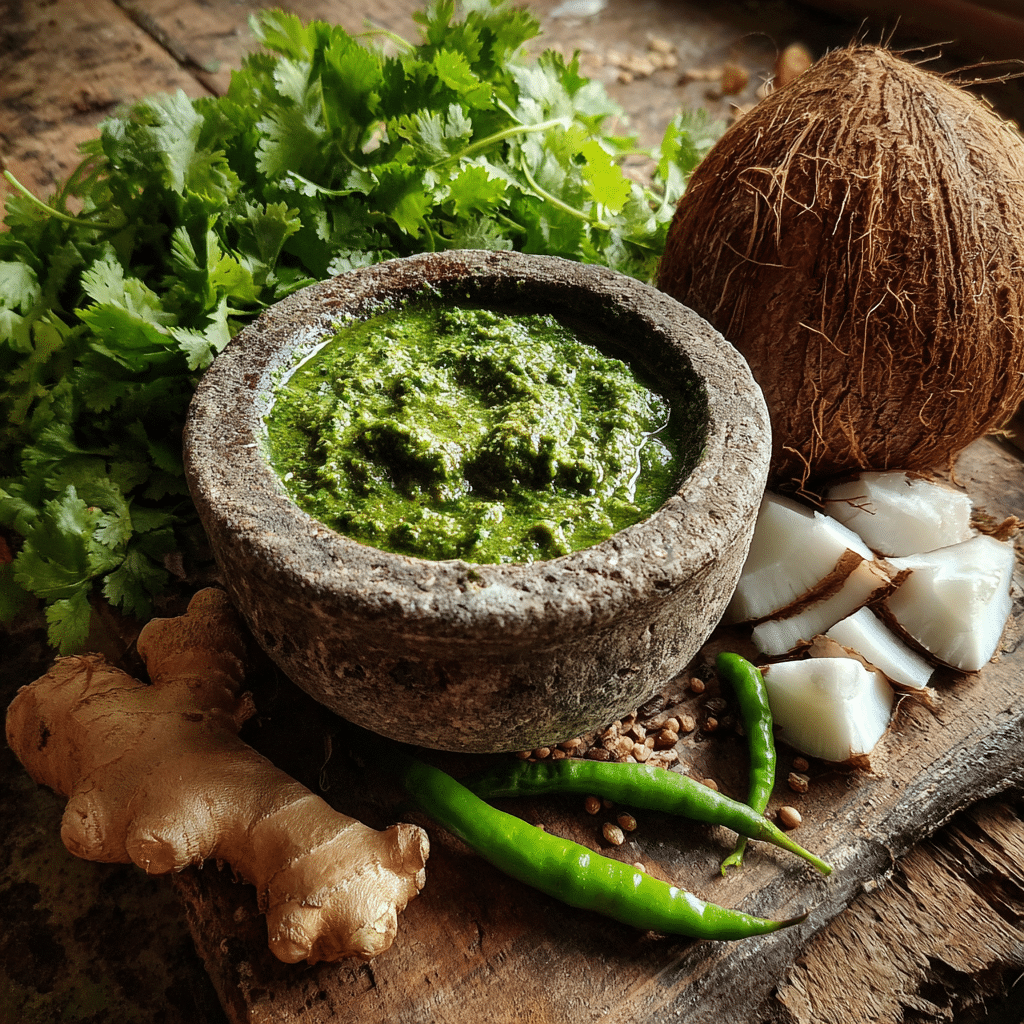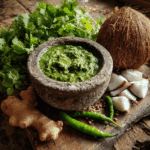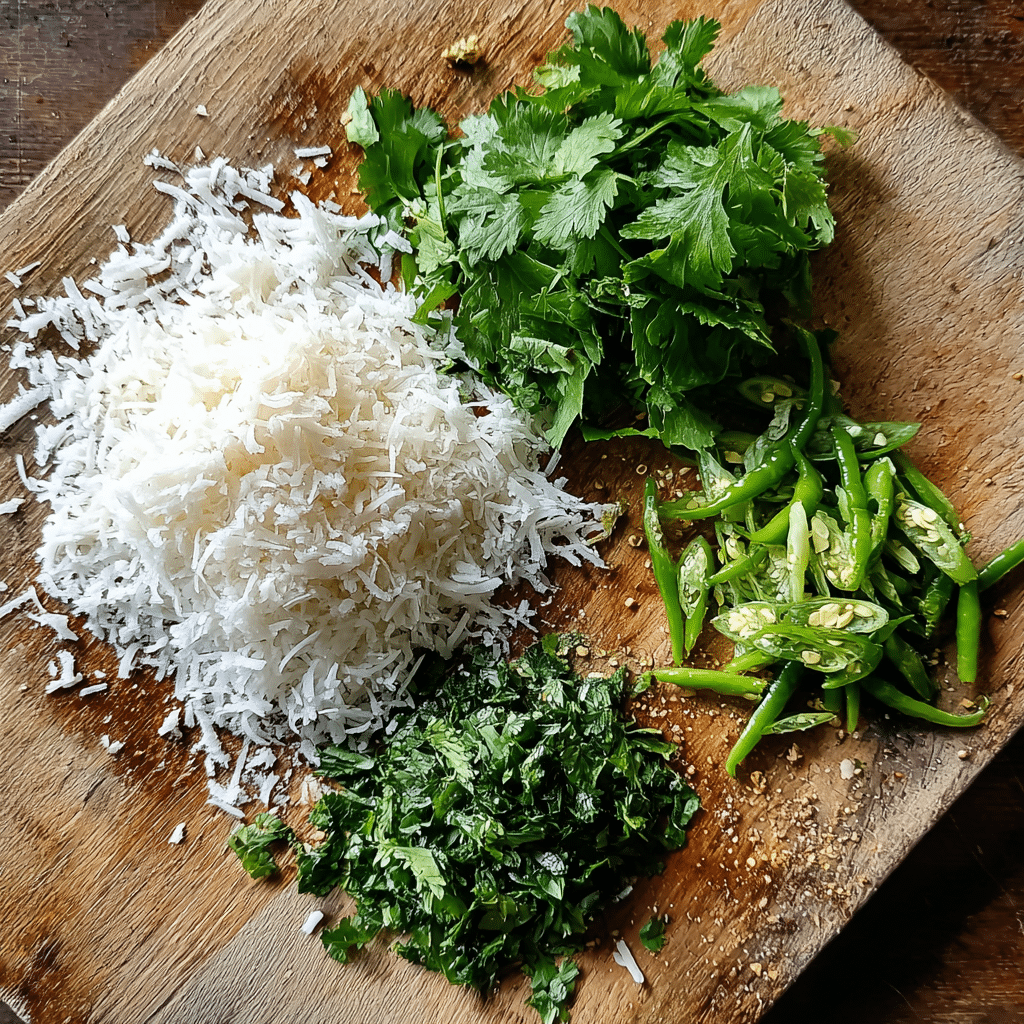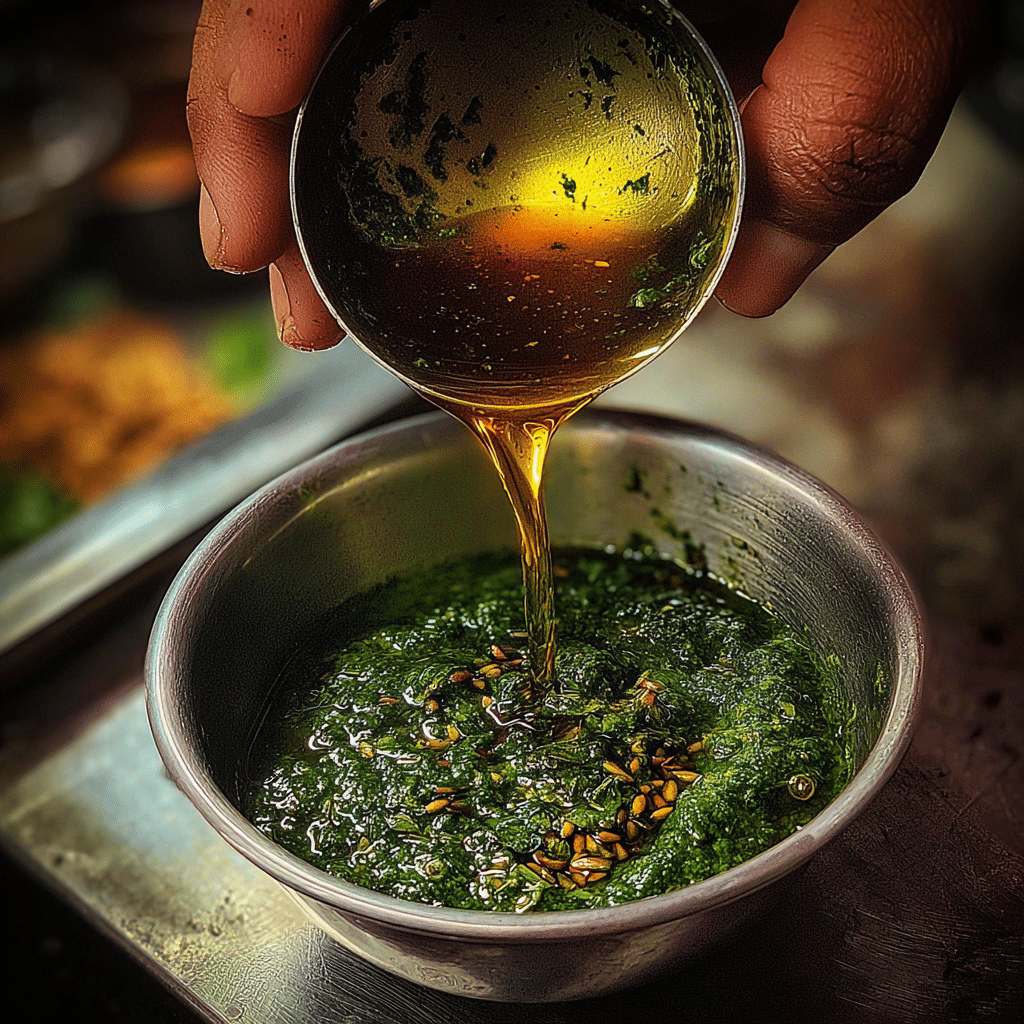When it comes to elevating Indian meals with a burst of flavor, hands coriander coconut chutney stands out as a go-to classic. This creamy, herb-packed condiment is not just a side dish—it’s an experience. Rich in texture, loaded with nutrients, and brimming with fresh flavors, this chutney combines the cooling properties of coconut with the zesty kick of coriander leaves. Whether you’re pairing it with dosa, idli, or even a sandwich,Its versatility and health benefits make it a staple in kitchens across South Asia. Freshly made hands coriander coconut chutney adds both nutrition and comfort to daily meals.
In this ultimate guide, you’ll learn everything about hands coriander coconut chutney, from its nutritional perks to traditional recipes, diabetic considerations, and cultural roots. Don’t miss our homemade secrets, pairing tips, and storage hacks that help you serve freshness every time.
Looking for inspiration? Try our Parmesan Crusted Chicken with Creamy Garlic Sauce as a creative fusion plate that pairs surprisingly well with this chutney twist.


Hands Coriander Coconut Chutney: Your Ultimate Guide To Homemade Freshness
- Total Time: 12 minutes
- Yield: 3 servings 1x
Description
Hands coriander coconut chutney is a vibrant and creamy Indian condiment made with fresh coconut, coriander leaves, green chili, and warming spices. Perfect with dosa, idli, or as a spread, this chutney brings freshness and nutrition to any meal.
Ingredients
1 cup fresh grated coconut (or thawed frozen coconut)
½ cup coriander leaves, chopped (with tender stems)
1 green chili (adjust to spice preference)
½ inch fresh ginger
2 tbsp roasted chana dal (optional, for texture and protein)
Salt to taste
¼ cup cold water (adjust as needed)
Juice of ½ lemon (or 1 tsp tamarind pulp for variation)
For tempering (optional):
1 tsp coconut oil (or neutral oil)
½ tsp mustard seeds
½ tsp urad dal
5 curry leaves
A pinch of hing (asafoetida)
Instructions
1. Add coconut, coriander, chili, ginger, chana dal, salt, and water to a blender.
2. Blend until smooth or slightly coarse, depending on texture preference.
3. Stir in lemon juice (or tamarind) and adjust salt if needed.
4. For tempering, heat oil in a small pan. Add mustard seeds and let them pop.
5. Add urad dal, curry leaves, and hing. Sauté until golden.
6. Pour tempering over the chutney and mix well.
7. Serve fresh or chill before serving for enhanced flavor.
Notes
For a spicier version, add more green chilies or a small garlic clove.
For a cooling variation, mix in 1 tablespoon of plain yogurt.
Keto Tip: Replace chana dal with soaked almonds or sunflower seeds.
Use within 2–3 days. Refrigerate in an airtight container.
- Prep Time: 10 minutes
- Cook Time: 2 minutes
- Category: Condiment, Chutney
- Method: Blending + Tempering
- Cuisine: Indian (South Indian-inspired)
Nutrition
- Serving Size: ~2 tablespoons
- Calories: 110
- Sugar: 1.3g
- Sodium: 128mg
- Fat: 9.6g
- Saturated Fat: 7.2g
- Unsaturated Fat: 2.4g
- Trans Fat: 0g
- Carbohydrates: 5.1g
- Fiber: 2.2g
- Protein: 2.1g
- Cholesterol: 0mg
Introduction to Hands Coriander Coconut Chutney
What Is Hands Coriander Coconut Chutney?
Hands coriander coconut chutney is a blended Indian condiment made using grated fresh coconut, green coriander leaves (cilantro), green chilies, ginger, and sometimes roasted chana dal or garlic. The name “hands” likely refers to the traditional preparation method, where chutney is made by hand-ground ingredients using a stone mortar and pestle, maintaining the original texture and flavor.
It’s particularly popular in southern Indian households where coconut is a daily ingredient, but the addition of coriander gives it a north-south fusion twist that enhances its aroma, taste, and presentation. Hands coriander coconut chutney is served chilled and typically tempered with mustard seeds, curry leaves, and hing (asafoetida) to enrich its flavor profile.
Brief Origin and Cultural Relevance in Indian Cuisine
The origin of this chutney stems from the culinary diversity of India, where regional chutneys act as both health boosters and flavor enhancers. While pure coconut chutney hails from Kerala and Tamil Nadu, the inclusion of coriander brings in freshness from North Indian styles. Together, they strike a unique balance that makes it suitable for all kinds of regional dishes, from dosa and vada in the south to parathas and snacks in the north.
Across generations, this recipe has been a staple in homes and temples alike. It’s vegan, gluten-free, and easily adjustable to suit modern diets, including keto or low-carb plans. Families pass down their personalized versions of hands coriander coconut chutney—some add garlic, others prefer tamarind or lemon. But the soul of hands coriander coconut chutney lies in its natural, clean ingredients blended to perfection.
Don’t miss our Lemon Balm Tea Recipe for Weight Loss—a soothing beverage that complements the freshness of this chutney beautifully.
The Health Benefits of Coconut Chutney
Nutritional Value of Fresh Coconut
Coconut is more than just a tasty base for chutney. It’s loaded with healthy fats, essential minerals, and fiber that can fuel your body and keep your digestion in check. When used in hands coriander coconut chutney, it brings not only creaminess but also serious health perks.
The fats in coconut are primarily medium-chain triglycerides, which are easier to digest than other types of fats. These MCTs may even help with weight management because they provide a quick energy boost and help you feel fuller for longer. On top of that, coconut contains important nutrients like magnesium and iron, which support metabolism and blood health.
Here’s a quick breakdown of what fresh coconut brings to the table:
| Nutrient | Per 100g |
|---|---|
| Calories | 354 kcal |
| Fat | 33g |
| Fiber | 9g |
| Protein | 3g |
| Iron | 2.4mg |
| Magnesium | 32mg |
Adding coconut to your meals in chutney form is a smart way to boost nutrition while keeping things delicious and light.
Is Coconut Chutney Good for Your Gut and Digestion?
Yes, coconut chutney is incredibly gut-friendly when made fresh and consumed in the right portion. One of the main reasons is its fiber content. Fiber in hands coriander coconut chutney helps regulate bowel movements and supports a healthy digestive system. It also feeds the good bacteria in your gut, which is essential for immune health and nutrient absorption.
The natural fats in coconut contain a compound called lauric acid. Lauric acid has antibacterial and antiviral properties that help reduce harmful bacteria in the gut while maintaining healthy microbial balance. This can lead to fewer digestive issues over time and improved gut function.
Traditional chutney recipes often include fresh ginger and green chili. Ginger is well known for calming the stomach, reducing gas, and stimulating saliva and bile production. Green chili, although spicy, can actually encourage your digestive system to produce enzymes that help break down food faster and more efficiently.
Also, the fact that coconut chutney is usually served raw plays a big role. Fresh, uncooked ingredients retain natural enzymes, which help your body digest food better. That’s a key reason why so many people feel light and satisfied after a meal that includes hands coriander coconut chutney.
Looking for something to balance your plate? Try our Sugar-Free Lemon Blueberry Pudding Cake. It’s a smart way to end your meal on a clean, gut-happy note.
The Power of Coriander in Your Chutney
What Is Coriander Chutney Good For?
Coriander isn’t just a finishing touch on your meals. It’s one of the most underrated yet powerful herbs used in Indian cooking, especially when it comes to chutneys. When blended into hands coriander coconut chutney, coriander brings a bright color, zesty flavor, and a strong dose of health benefits.
These vibrant green leaves are packed with essential nutrients like vitamin A, vitamin C, and vitamin K. They help strengthen your immune system, promote glowing skin, and support heart health. Coriander also has natural cleansing properties, which help your body get rid of toxins and reduce internal inflammation.
One of its best qualities is how it supports digestion. The natural oils in coriander stimulate the production of digestive enzymes, making it easier for your body to break down food. People with sensitive stomachs often find coriander-based chutneys light and soothing. In fact, some early studies suggest that it may help regulate blood sugar levels, which makes it a smart pick for diabetic-friendly meals.
So, what is coriander chutney really good for? It helps your digestion, cleans your system, nourishes your skin, and keeps your meals bursting with flavor.
If you’re a fan of nutrient-rich meals, take a look at our High Protein Chicken Salad. It’s a delicious way to stay full and energized.
Phytochemicals, Antioxidants, and Detox Benefits
Coriander is full of plant-based compounds that act as natural healers inside your body. These are called phytochemicals, and they help protect your cells from damage caused by oxidative stress. That means they help slow down signs of aging and support the immune system.
By adding coriander to your meals, you get some serious perks:
- Natural detox effects that help your liver clear out harmful substances
- Anti-inflammatory compounds that reduce discomfort in the gut and joints
- Better skin health thanks to high vitamin C and chlorophyll content
- Blood sugar regulation from specific bioactive compounds in the leaves
When you combine coriander with the smooth texture of coconut and a bit of spice, you’re not just making a tasty dip. You’re creating something nourishing that complements your body’s natural rhythm and enhances overall wellness.
Want to explore more recipes that work with your body instead of against it? Try our Pink Salt Trick Recipe. It’s another simple yet effective way to support balance and digestion through real ingredients.
Crafting the Perfect Hands Coriander Coconut Chutney
Traditional Recipe with Step-by-Step Instructions
When you want something simple, fresh, and packed with flavor, hands coriander coconut chutney never disappoints. This versatile recipe brings together coconut’s creamy richness with the earthy freshness of coriander for a side that fits breakfast, lunch, or dinner.

Here’s how to make it from scratch using basic kitchen ingredients.
Ingredients:
- 1 cup fresh grated coconut (or thawed if frozen)
- 1/2 cup chopped coriander leaves (stems included)
- 1 green chili (adjust for your spice level)
- 1/2 inch fresh ginger
- 2 tablespoons roasted chana dal (optional)
- Salt to taste
- 1/4 cup cold water (use more if needed)
- Juice of half a lemon (optional)
For tempering (optional):
- 1 teaspoon coconut oil (or neutral oil)
- 1/2 teaspoon mustard seeds
- 1/2 teaspoon urad dal
- 5 curry leaves
- A pinch of hing (asafoetida)
Instructions:
- Add the coconut, coriander, green chili, ginger, chana dal, and salt to your blender.
- Pour in a little cold water and blend until smooth. Keep it slightly coarse if you prefer texture.
- Adjust salt and spice to your liking. Squeeze in lemon juice for extra brightness if desired.
- In a small pan, heat the oil and toss in the mustard seeds. Let them crackle to release flavor.
- Add the urad dal, curry leaves, and hing. Sauté until the dal browns slightly and everything becomes aromatic.
- Transfer the tempering into the chutney and stir gently to mix everything together.

This hands coriander coconut chutney is enough for 2 to 3 servings. It’s perfect alongside dosa, idli, pongal, or vada. You can also get creative—it works wonderfully as a sandwich spread or a dip for wraps.
Craving a meal with layers of flavor? Pair this with our Instant Pot Seafood Boil for a satisfying and bold combination.
Creative Variations for Keto, Vegan, and Spicy Palates
This chutney is as flexible as it is flavorful. Here are some smart ways to tweak the original hands coriander coconut chutney recipe to match your taste or dietary goals.
Keto-Friendly Version
To make it low-carb, leave out the roasted chana dal. You can substitute with soaked almonds or sunflower seeds, which help add thickness and keep the texture creamy without raising carb levels.
Vegan Protein Boost
Want to make it more nutritious? Add flaxseeds, hemp seeds, or a handful of cashews. These ingredients not only add a rich, smooth texture but also pack in healthy plant protein and good fats.
Spicy Twist
For those who love a fiery kick, throw in an extra green chili or a clove of fresh garlic. A small chunk of raw onion also deepens the flavor, giving it a more robust finish.
Cooling Yogurt Blend
If you prefer a mellow taste, especially in summer, stir in a spoonful of plain, unsweetened yogurt. It balances the heat and makes the chutney creamier and more soothing—great for kids too.
South Indian Tang
To bring out a deeper, more traditional flavor, swap lemon juice with a bit of soaked tamarind pulp. This gives the chutney a rich, tangy taste that pairs beautifully with rice dishes.
Looking for more ways to simplify your cooking while keeping flavors bold and exciting? Don’t miss our Zepbound Recipe Shortcuts for clever hacks that save time without compromising on taste.
Coconut vs Coriander – Flavor, Texture, and Nutrient Differences
How These Ingredients Complement Each Other
The beauty of hands coriander coconut chutney lies in how two simple ingredients—coconut and coriander—work in harmony. On their own, they each offer unique textures and tastes. But together, they create a balance that’s both satisfying and refreshing.
Coconut brings a rich, creamy consistency. It has a slightly sweet, nutty flavor that acts as the base of the chutney. When blended, coconut gives the dish a velvety body that helps other ingredients stick and spread well.
Coriander, on the other hand, is light, leafy, and bold. Its slightly citrusy, herbaceous aroma cuts through the heaviness of coconut and adds freshness. This contrast is what makes the chutney feel light yet filling, bold but not overpowering.
The marriage of these two flavors ensures every bite is balanced. The creaminess soothes your palate, while the herbaceous lift from coriander keeps it vibrant and digestible.
If you’re looking for that kind of balanced flavor in your main course, check out our High Protein Chicken Salad—a fresh yet filling option to serve alongside hands coriander coconut chutney.
Why the Blend Works: The Science Behind the Taste
Coconut is high in healthy fats, primarily medium-chain triglycerides (MCTs), which give the chutney a full-bodied mouthfeel and help carry flavors across your tongue. It also has natural sugars and fiber, which contribute to both taste and gut health.
Coriander, rich in antioxidants and essential oils, sharpens the flavor profile. Its phytonutrients stimulate digestion and may reduce inflammation, making the chutney more than just a flavorful side—it’s a functional food too.
From a nutritional perspective, the combination covers a range of benefits. Coconut provides energy and satiety, while coriander offers cleansing and anti-inflammatory support. When blended into hands coriander coconut chutney, they form a superfood pairing that supports digestion, heart health, and even blood sugar balance when eaten in moderation.
Don’t miss our Cottage Cheese Chocolate Mousse if you’re seeking a high-protein dessert that contrasts beautifully with the herbal freshness of this chutney.
Pairing Ideas for Chutney Lovers
Best Dishes to Pair with Hands Coriander Coconut Chutney
One of the reasons hands coriander coconut chutney is such a beloved condiment is its versatility. It goes beyond South Indian breakfasts and adds flavor to a variety of meals across the day. Whether you’re keeping things traditional or experimenting, hands coriander coconut chutney makes every meal brighter.
Here are some of the best foods to pair with it:
| Dish | Why It Works |
|---|---|
| Dosa | Crispy exterior meets creamy chutney for contrast |
| Idli | Fluffy texture absorbs the chutney’s bold flavor |
| Vada | Crunchy and spicy, balanced by the chutney’s coolness |
| Pesarattu | Earthy taste enhanced by fresh herbs and coconut |
| Plain rice with ghee | Rich and simple, transformed with a spoon of chutney |
| Rava Upma | Mild taste made interesting with herbaceous depth |
| Pakoras or fritters | Dips perfectly into the chutney for added spice |
Beyond Indian classics, you can spread hands coriander coconut chutney inside wraps, pita sandwiches, or even use it as a dip for grilled vegetables and roasted chicken.
Don’t miss our Pancake Tacos—a fun twist where this chutney can double as a savory spread.
Breakfast, Lunch, and Snack Pairing Suggestions
For Breakfast:
Start your day with a nourishing plate of idli, dosa, or ragi roti served with a bowl of hands coriander coconut chutney on the side. It’s light on the stomach, yet packed with flavor and nutrients.
For Lunch:
Pair the chutney with steamed rice and a spoon of ghee for a soul-soothing, simple lunch. You can also use it in lunchbox wraps or grain bowls to avoid the usual heavy sauces.
For Snacks:
Use the chutney as a dip for evening snacks like pakoras, samosas, or multigrain crackers. The combination of fresh herbs and creamy coconut offers a welcome change from ketchup or mayonnaise.
For Fusion Meals:
Looking to modernize your meal prep? Add a spoon of hands coriander coconut chutney to quinoa bowls, millet patties, or chickpea salad wraps. It delivers depth, color, and a health boost.
Want something sweet to complement your chutney-based meals? Explore our refreshing Blueberry Coffee Cake Recipe for a balanced dessert pairing.
Indian vs British Chutney – Key Differences Explained
Historical Evolution of Chutneys in the East and West
Chutney, as a concept, has existed for centuries, but its identity and use have evolved significantly depending on the region. In India, chutneys are fresh, herb-based condiments made to be consumed immediately. They’re often raw, made with natural ingredients like coconut, coriander, mint, curry leaves, or tamarind, and they’re intended to enhance a meal’s freshness and flavor.
In contrast, British-style chutneys—originally inspired by Indian cuisine during colonial times—have been adapted into sweet-and-sour, preserved relishes. These chutneys are typically cooked and jarred, combining fruits like mangoes or apples with vinegar, sugar, and spices. They often resemble jams in texture and shelf life.
So while both versions may fall under the “chutney” label, their purpose and preparation are vastly different. British chutneys are intended to last and be stored for months, while Indian chutneys like hands coriander coconut chutney are all about immediacy, nutrition, and fresh taste.
Looking for more globally inspired meals? Don’t miss our Hello Fresh Tex Mex Paste Recipe—a fusion condiment that’s great with wraps, tacos, or rice bowls.
Taste, Texture, and Ingredient Differences
Here’s a quick breakdown to understand the core contrasts between these two chutney styles:
| Feature | Indian Chutney | British Chutney |
|---|---|---|
| Base Ingredients | Herbs, coconut, spices, raw veggies | Fruits, vinegar, sugar, dried spices |
| Texture | Smooth, semi-liquid, or grainy | Thick, jam-like, spoonable |
| Flavor Profile | Fresh, spicy, tangy, herbaceous | Sweet, tangy, spiced, mellow |
| Shelf Life | 1–3 days in fridge | Several months in sealed jars |
| Cooking | Often raw or lightly tempered | Fully cooked and simmered |
When you’re making something like hands coriander coconut chutney, you’re focusing on freshness, digestibility, and live ingredients. It’s about creating a side that’s alive with flavor and meant to be enjoyed the same day.
On the other hand, British chutneys are perfect for those who love slow-cooked, rich flavors with a long shelf life—ideal for cheese boards or cold meats, but quite different in culinary philosophy.
If you’re exploring chutneys for the first time, the fresh zing of a homemade Indian-style one is a great place to start.
Does Coconut Chutney Spike Blood Sugar?
Glycemic Index of Coconut and Coconut Milk
When it comes to managing blood sugar, many people worry about the impact of coconut. But here’s the good news—fresh coconut has a low glycemic index (GI). That means it causes only a gradual rise in blood sugar, unlike refined carbs or sugary sauces.
Most of the carbs in coconut come from fiber, which slows digestion and improves insulin sensitivity. On top of that, coconut contains healthy fats (mainly MCTs) that provide energy without causing glucose spikes. Whether you’re using grated coconut or coconut milk, the blood sugar impact is minimal, especially in small servings.
This makes hands coriander coconut chutney a smart choice for those monitoring their glucose levels. As long as you control the portion and avoid pairing it with high-GI foods, it can easily fit into a diabetic-friendly diet.
For more metabolism-boosting recipes, try our Pink Salt Diet Recipe—a great addition to a wellness-conscious eating plan.
Best Practices for Diabetics Consuming Coconut Chutney
If you’re diabetic or prediabetic, here are a few tips to safely enjoy hands coriander coconut chutney:
- Watch portion size: Limit to 2–3 tablespoons per meal.
- Skip added sugar or sweet chutney versions: Traditional Indian chutneys don’t need sugar at all.
- Add protein on the side: Pair the chutney with boiled eggs, paneer, or lentils to reduce any potential glucose spikes.
- Avoid refined carbs: Instead of pairing with white rice or white bread, serve it with whole grains or steamed vegetables.
Also, remember that most of the ingredients in this chutney—like coriander, ginger, and coconut—are actually helpful for blood sugar control. Coriander is known to support insulin function, and ginger has anti-inflammatory properties that help balance glucose metabolism.
In moderation, hands coriander coconut chutney can be both flavorful and functional for anyone monitoring their glucose
Interested in more low-sugar treats? Check out our Sugar-Free Lemon Blueberry Pudding Cake for a dessert that satisfies without spiking blood sugar.
Storage, Shelf Life, and Preservation Tips
How to Store Homemade Chutney for Longer Freshness
Because it’s made with real, raw ingredients, hands coriander coconut chutney doesn’t contain the preservatives you’d find in store-bought sauces or shelf-stable dips. That means it’s best enjoyed fresh—but there are still smart ways to keep it tasting great for a day or two.
To get the most out of your chutney, follow these easy storage practices:
- Use freshly grated coconut. Whether it’s from scratch or frozen and thawed, make sure the coconut is as fresh as possible before blending.
- Store in a clean, airtight container. Glass or food-safe plastic works best to lock in flavor and prevent moisture loss.
- Refrigerate right after making. Keep the chutney cool within 30 minutes of preparation to prevent spoilage.
- Avoid double-dipping. Always use a dry, clean spoon to scoop. Even a little moisture can reduce its shelf life.
When properly stored in the refrigerator, hands coriander coconut chutney stays fresh for up to 48 hours. After that, you may notice changes in flavor and consistency.
Try our Cloud Cake Recipe if you’re planning a full-course meal. It makes a perfect follow-up to a savory dish served with chutney.
Refrigeration, Freezing, and Zero-Preservative Tips
Refrigeration is the safest and most effective way to keep your chutney flavorful. But if you need to store it longer, freezing is an option—though keep in mind the texture may change slightly after thawing.
Here’s how to freeze it the right way:
- Portion first. Spoon the chutney into silicone molds or ice cube trays for single-serve sizes.
- Freeze until firm. Leave in the freezer for a few hours or overnight.
- Repack into freezer containers. Once frozen solid, pop out the cubes and place them into an airtight freezer-safe pouch or container for extended storage.
To serve, just thaw hands coriander coconut chutney in the fridge or use the microwave on a low setting. Stir well after defrosting to restore consistency.
For preservative-free freshness, stick with natural stabilizers like lemon juice, and include tempering with mustard seeds and hing. These ingredients don’t just add flavor—they also help keep bacteria in check naturally.
Looking for more fresh kitchen staples? Check out our Homemade Mounjaro Recipe with Pink Salt for a zero-additive option that complements your clean eating approach.
Conclusion
Whether you’re enjoying a hearty breakfast or a fresh grain bowl, hands coriander coconut chutney is the ideal companion.It blends the richness of coconut with the vibrant kick of coriander, creating a balanced condiment that fits beautifully into both traditional and modern meals.
From digestive support and blood sugar control to customizable variations for every diet, this chutney is much more than a side—it’s a nutritional powerhouse. With just a few ingredients and minutes in the kitchen, you can whip up a batch that enhances any plate, from dosa to grain bowls to veggie wraps.
Don’t miss our Caramel Brulee Latte for a warm, indulgent pairing that follows your chutney-based meal beautifully.
Find more recipes on our Pinterest and Medium pages—new ones added all the time!
Frequently Asked Questions (FAQs)
Is coconut chutney good for your gut?
Yes, coconut chutney is generally great for digestion. Fresh coconut is rich in dietary fiber, which supports regular bowel movements and promotes a healthy gut environment. It also contains natural fats that soothe the digestive tract. When paired with herbs like coriander and spices like ginger, the effect becomes even more gut-friendly. That’s why hands coriander coconut chutney is not just tasty—it’s also beneficial for your stomach.
What is coriander chutney good for?
Hands coriander coconut chutney is packed with antioxidants and loaded with vitamins A, C, and K. It’s known for improving digestion, detoxifying the liver, and helping to reduce inflammation. Coriander is also rich in vitamins A, C, and K, which promote immunity and skin health. When used in hands coriander coconut chutney, it adds a fresh, herbal kick that enhances both flavor and wellness.
What is the difference between Indian chutney and British chutney?
Indian chutneys are typically made fresh using raw herbs, coconut, chilies, and spices. They’re meant to be consumed immediately and have bold, vibrant flavors. British chutneys, on the other hand, are cooked, jarred, and preserved using fruits, sugar, and vinegar. They tend to be sweet and mellow with a longer shelf life. A recipe like hands coriander coconut chutney is a perfect example of traditional Indian chutney, emphasizing freshness and nutrition.
Does coconut chutney spike blood sugar?
Not likely. Coconut has a low glycemic index and is full of healthy fats and fiber. These elements slow down sugar absorption and help manage glucose levels. When eaten in small portions and paired with protein or fiber-rich meals, coconut chutney—even in the form of hands coriander coconut chutney—can fit well into a diabetic-friendly diet.

